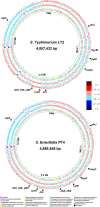Transcriptomic responses of Salmonella enterica serovars Enteritidis and Typhimurium to chlorine-based oxidative stress
- PMID: 20562293
- PMCID: PMC2916494
- DOI: 10.1128/AEM.00823-10
Transcriptomic responses of Salmonella enterica serovars Enteritidis and Typhimurium to chlorine-based oxidative stress
Abstract
Salmonella enterica serovars Enteritidis and Typhimurium are the leading causative agents of salmonellosis in the United States. S. Enteritidis is predominantly associated with contamination of shell eggs and egg products, whereas S. Typhimurium is frequently linked to tainted poultry meats, fresh produce, and recently, peanut-based products. Chlorine is an oxidative disinfectant commonly used in the food industry to sanitize the surfaces of foods and food processing facilities (e.g., shell eggs and poultry meats). However, chlorine disinfection is not always effective, as some S. enterica strains may resist and survive the disinfection process. To date, little is known about the underlying mechanisms of how S. enterica responds to chlorine-based oxidative stress. In this study, we designed a custom bigenome microarray that consists of 385,000 60-mer oligonucleotide probes and targets 4,793 unique gene features in the genomes of S. Enteritidis strain PT4 and S. Typhimurium strain LT2. We explored the transcriptomic responses of both strains to two different chlorine treatments (130 ppm of chlorine for 30 min and 390 ppm of chlorine for 10 min) in brain heart infusion broth. We identified 209 S. enterica core genes associated with Fe-S cluster assembly, cysteine biosynthesis, stress response, ribosome formation, biofilm formation, and energy metabolism that were differentially expressed (>1.5-fold; P < 0.05). In addition, we found that serovars Enteriditis and Typhimurium differed in the responses of 33 stress-related genes and 19 virulence-associated genes to the chlorine stress. Findings from this study suggest that the oxidative-stress response may render S. enterica resistant or susceptible to certain types of environmental stresses, which in turn promotes the development of more effective hurdle interventions to reduce the risk of S. enterica contamination in the food supply.
Figures



Similar articles
-
Response of foodborne Salmonella spp. marker strains inoculated on egg shell surfaces to disinfectants in a commercial egg washer.J Environ Sci Health B. 2001 Mar;36(2):219-27. doi: 10.1081/PFC-100103745. J Environ Sci Health B. 2001. PMID: 11409500
-
Multiple Drug Resistance and Virulence Profiling of Salmonella enterica Serovars Typhimurium and Enteritidis from Poultry Farms of Faisalabad, Pakistan.Microb Drug Resist. 2019 Jan/Feb;25(1):133-142. doi: 10.1089/mdr.2018.0121. Epub 2018 Aug 16. Microb Drug Resist. 2019. PMID: 30113248
-
Changes in thermo-tolerance and survival under simulated gastrointestinal conditions of Salmonella Enteritidis PT4 and Salmonella Typhimurium PT4 in chicken breast meat after exposure to sequential stresses.Int J Food Microbiol. 2017 Jun 19;251:15-23. doi: 10.1016/j.ijfoodmicro.2017.03.022. Epub 2017 Mar 29. Int J Food Microbiol. 2017. PMID: 28380343
-
Prevention and Control of Human Salmonella enterica Infections: An Implication in Food Safety.Int J Food Sci. 2023 Sep 11;2023:8899596. doi: 10.1155/2023/8899596. eCollection 2023. Int J Food Sci. 2023. PMID: 37727836 Free PMC article. Review.
-
Disinfectants and one health review: The role of reactive oxygen species in the bactericidal activity of chlorine against Salmonella.One Health. 2025 Feb 6;20:100989. doi: 10.1016/j.onehlt.2025.100989. eCollection 2025 Jun. One Health. 2025. PMID: 40035020 Free PMC article. Review.
Cited by
-
A Capillary Electrophoresis Method Based on Molecularly Imprinted Solid-Phase Extraction for Selective and Sensitive Detection of Histamine in Foods.Molecules. 2022 Oct 17;27(20):6987. doi: 10.3390/molecules27206987. Molecules. 2022. PMID: 36296580 Free PMC article.
-
Gene expression analysis of Salmonella enterica Enteritidis Nal(R) and Salmonella enterica Kentucky 3795 exposed to HCl and acetic acid in rich medium.Foodborne Pathog Dis. 2012 Apr;9(4):331-7. doi: 10.1089/fpd.2011.0984. Epub 2012 Feb 22. Foodborne Pathog Dis. 2012. PMID: 22356573 Free PMC article.
-
Surviving Reactive Chlorine Stress: Responses of Gram-Negative Bacteria to Hypochlorous Acid.Microorganisms. 2020 Aug 11;8(8):1220. doi: 10.3390/microorganisms8081220. Microorganisms. 2020. PMID: 32796669 Free PMC article. Review.
-
The secondary metabolite hydrogen cyanide protects Pseudomonas aeruginosa against sodium hypochlorite-induced oxidative stress.Front Microbiol. 2023 Nov 16;14:1294518. doi: 10.3389/fmicb.2023.1294518. eCollection 2023. Front Microbiol. 2023. PMID: 38033579 Free PMC article.
-
The ArcAB two-component regulatory system promotes resistance to reactive oxygen species and systemic infection by Salmonella Typhimurium.PLoS One. 2018 Sep 4;13(9):e0203497. doi: 10.1371/journal.pone.0203497. eCollection 2018. PLoS One. 2018. PMID: 30180204 Free PMC article.
References
-
- Akeda, Y., and J. E. Galan. 2005. Chaperone release and unfolding of substrates in type III secretion. Nature 437:911-915. - PubMed
-
- Baron, F., R. Storb, B. E. Storer, M. B. Maris, D. Niederwieser, J. A. Shizuru, T. R. Chauncey, B. Bruno, S. J. Forman, P. A. McSweeney, R. T. Maziarz, M. A. Pulsipher, E. D. Agura, J. Wade, M. Sorror, D. G. Maloney, and B. M. Sandmaier. 2006. Factors associated with outcomes in allogeneic hematopoietic cell transplantation with nonmyeloablative conditioning after failed myeloablative hematopoietic cell transplantation. J. Clin. Oncol. 24:4150-4157. - PubMed
-
- Benjamini, Y., and Y. Hochberg. 1995. Controlling the false discovery rate: a practical and powerful approach to multiple testing. J. R. Stat. Soc. Ser. B Methodol. 57:289-300.
Publication types
MeSH terms
Substances
Associated data
- Actions
LinkOut - more resources
Full Text Sources
Molecular Biology Databases
Miscellaneous

